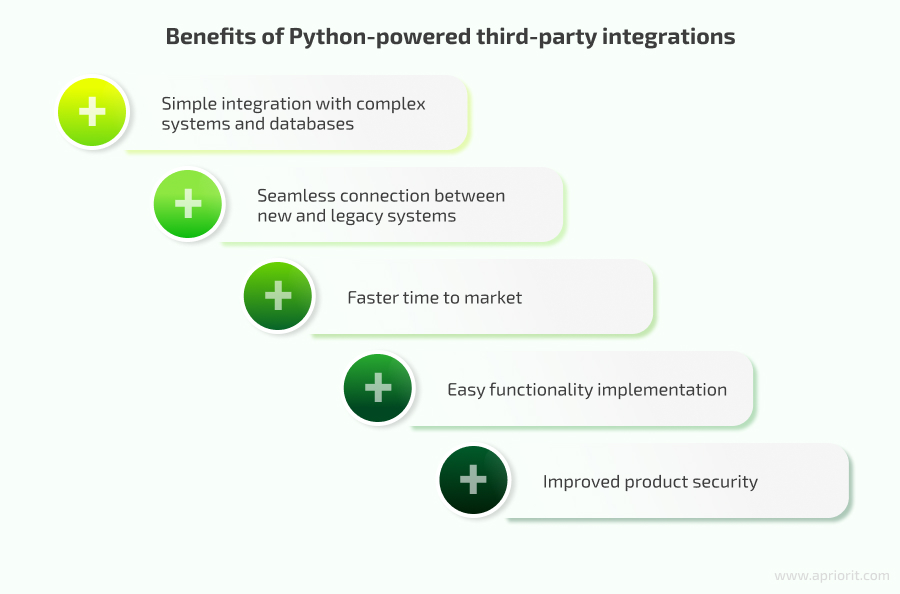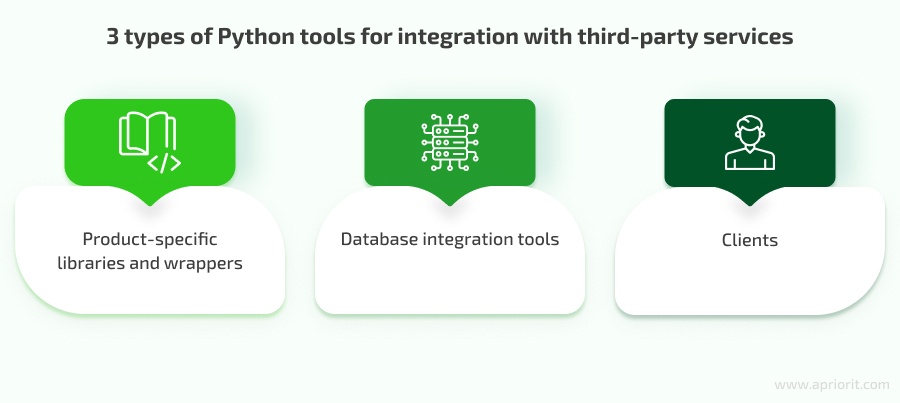The Python programming language is increasingly popular for web development, enterprise solutions, SaaS technologies, and system administration.
It’s impossible to imagine modern software that doesn’t use third-party integrations. Seamless integrations are paramount for product success, as they allow you to enhance functionality without having to reinvent the wheel. Creating a solution that’s connected to other services, SaaS platforms, and web products helps you deliver a truly efficient and functional ecosystem.
Despite their benefits, third-party integrations come with their own set of challenges, including diverse protocols and security issues. Many developers choose Python to overcome these challenges, as the Python community offers extensive libraries, frameworks, and software development kits (SDKs) that allow for easy and smooth integration with third-party services.
In this article, we explore how Python can help you seamlessly integrate third-party services into your own product and look at the most popular Python tools for integration with third-party programs. This article will be helpful for development and product leaders who build software with Python or want to power their existing or legacy systems with new functionality by integrating Python modules.
Contents:
Why use Python for third-party integrations?
Enriching solutions with third-party integrations is vital for businesses. It helps you ensure secure, fast, and efficient software development, as well as deliver top-notch services. Third-party integrations offer businesses more than just a connection to other services. Here are a few additional benefits:

Python allows development teams to easily integrate different systems with each other, and this is especially beneficial for:
- Enterprises that require integrations with other systems. Python makes it easy to integrate existing software with complex systems, databases, SaaS platforms, etc. You can use Python to integrate with a third-party CRM and automatically send information to it. This allows you to increase the efficiency of your business operations and reduce costs.
- Businesses that need to use new technologies for their legacy systems. Python has a great selection of libraries that allow developers to glue different technologies together. By using them, you can integrate different modules written in Python into legacy systems that use other technologies like C or C++. Python also offers libraries that facilitate interoperability between Python and other languages, allowing them to work together seamlessly.
- Product companies that prioritize time to market. Instead of developing something from scratch, you can use Python integrations for ready-made solutions that will save you development time and reduce costs associated with building and maintaining complex systems or features. Python integrations allow businesses to save money at the initial stages of product development and test their idea on the market with minimal investment while still delivering a functional and secure product.
- Organizations that want to easily expand their product’s functionality. Businesses of any size can stay relevant and competitive by integrating the newest technologies into their products through third-party integrations, such as by adding new payment systems, AI and ML features, and smart chatbots.
- Businesses that care for the security of their end product. Third-party integrations often come with built-in security features, such as authentication protocols, encryption methods, and compliance with security standards. Moreover, reliable and popular third-party service providers take care of their security and release updates and patches to protect their service from new security threats. However, this doesn’t mean that you can rely fully on your providers without taking care of security on your end.
As you can see, third-party integrations are beneficial to businesses of all sizes and in all industries. Many choose Python due to the large number of libraries, clients, and SDKs to further simplify the integration process.
Let’s take a closer look at the capabilities of third-party API integration best practices with Python and explore a few examples of Python tools for integration with third-party products.
Need to expand your product’s capabilities?
Power your software with fast and secure third-party integrations! Delegate this task to Apriorit’s team of experts.
Python tools for integration with third-party services
How does Python integrate with other technologies?
When developing any software, your team needs to ensure integration with third-party libraries, databases, and other IT products. To allow for integration with their services, software providers and communities offer public APIs that are usually implemented based on HTTP, SOAP, MQTT, or another protocol.
However, if you’re writing software in Python, you can leverage lots of special Python wrappers for third-party product APIs. Many commercial companies and developers from the Python community create such wrappers as an SDK or client library that can be downloaded from an official Python repository like PyPi.
Let’s take a closer look at the most commonly used and helpful tools for integrating your Python software with third-party services.

Product-specific libraries and wrappers
Large software providers often write solutions in Python to help you quickly and easily integrate their products with your software. A few famous examples of such tools are:
- Google API client — a client library that simplifies access to Google Cloud APIs and reduces the amount of code needed to use Google services remotely
- Facebook API library — a Python wrapper for the Facebook Common API
- Dropbox SDK — a tool to simplify use of the Dropbox API
Talking about third-party solution integration with Python, it’s worth mentioning McAfee products, as McAfee offers a bunch of libraries developed specifically for integration with McAfee services.
At Apriorit, we have experience integrating McAfee solutions in our projects to ensure efficient work and save time. For example, we once used the OpenDXL TIE library to send data about malicious files (stored in a knowledge database of the project under development) to the McAfee TIE server. Thus, McAfee TIE users could enrich their database with the newest information about malicious files. Thanks to the OpenDXL TIE library, our team was able to develop a project quite fast and with almost no issues along the way.
These are the most popular McAfee tools:
- OpenDXL is a library that makes it possible for third-party programs to interact with the McAfee Data Exchange Layer (DXL). The OpenDXL Python Client enables development of applications that connect to the McAfee Data Exchange Layer messaging fabric to send and receive events as well as invoke and provide services.
- OpenDXL TIE is another McAfee library that works as a wrapper for OpenDXL but is designed to solve a more specific problem: interacting with the Threat Intelligence Exchange module of McAfee DXL. The McAfee Threat Intelligence Exchange (TIE) DXL Python client library provides a high-level wrapper for the TIE Data Exchange Layer (DXL) API. This library allows users to access features of TIE (manage reputations, determine where a file has been executed, etc.) without having to focus on lower-level details such as TIE-specific DXL topics and message formats.
- McAfee SIEM API wrapper is a module designed to provide an API wrapper for principal McAfee SIEM API components.
Database integration tools
You can also easily integrate your Python product with the most commonly used relational databases such as MySQL and SQLite, as well as with NoSQL databases like MongoDB.
- MySQL Connector is an easy-to-use tool for integrating products written in Python with MySQL, which allows for conversion between Python and MySQL data types. MySQL Connector API is implemented using pure Python and doesn’t require any third-party libraries.
- SQLite3 is a module for integrating the SQLite database with Python. It provides a SQL interface compliant with the DB-API 2.0 specification and requires SQLite 3.7.15 or newer.
- PyMongo is a tool for working with MongoDB — one of the most popular NoSQL cross-platform and object-oriented databases. PyMongo provides a simple interface to maintain databases along with a library that comes with extensive and clear documentation.
The libraries we mentioned above are not the only ones supported by Python. As a language for creating database clients, Python can be integrated with all types of databases.
Read also
How to Develop Smart Chatbots Using Python: Examples of Developing AI- and ML-Driven Chatbots
Learn how to make an AI chatbot in Python to optimize your business processes and automate customer care.

Clients
Most midsize applications don’t need to implement special SDKs, libraries, and API wrappers because they often have quite narrow functionality that is easy to work with using only standard Python tools. Instead of developing custom wrappers, they create a public API (usually a REST API) that provides access to their functionality.
However, there are products that use other protocols like SOAP and MQTT. To integrate your Python solution with such products, you need to use special clients. Let’s explore a few:
1. SOAP clients. SOAP is an XML-based communication protocol for exchanging structured information. Here are a few Python clients that interact with SOAP servers:
- Zeep is a well-maintained library that provides an easy-to-use programmatic interface for interacting with a SOAP server and offers a wide range of functionality.
- SUDS is a lightweight SOAP client. Note that it requires installation of different packages for different versions of Python.
- PySimpleSOAP is a simple and lightweight Python SOAP library for client and server web service interfaces. It’s designed to be as small and easy to use as possible.
2. HTTP clients. Here are a few of the most popular Python wrappers that work with the HTTP protocol:
- Urllib3 is a powerful HTTP client for Python. The library supports many critical features such as uploading files with multipart encoding and pooling connections that are missing in standard Python libraries.
- Requests is a library built on top of urllib3. With a simple and user-friendly interface and limited functionality, this library is the best choice for small programs.
- Aiohttp is an asynchronous HTTP client/server for Python. Its API is designed to make the most of non-blocking network operations.
3. MQTT clients. MQTT is an OASIS standard messaging protocol for the Internet of Things (IoT). It’s designed as an extremely lightweight publish/subscribe messaging transport that is ideal for connecting remote devices with a small code footprint and minimal network bandwidth. Let’s explore a few examples of such clients:
- Paho-mqtt is one of the best Python MQTT open-source client libraries. It’s developed under the leadership of the Eclipse Foundation and implements versions 5.0, 3.1.1, and 3.1 of the MQTT protocol. Paho-mqtt provides a client class that enables applications to connect to an MQTT broker and publish messages, subscribe to topics, and receive published messages. It also provides helper functions to make publishing one-off messages to an MQTT server straightforward.
- HBMQTT is an open-source MQTT client and broker implementation built on top of the asyncio library, Python’s standard asynchronous I/O framework. HBMQTT provides a straightforward API based on coroutines, making it easy to write highly concurrent applications.
- Gmqtt is not as popular and well-developed as the previous two clients, since it’s an open-source tool created by an individual developer. Gmqtt supports the MQTT 5.0 protocol. The module is built on the asyncio library and requires Python 3.4 or newer.
The list of Python tools for integration with third-party solutions goes on and on. Above, we discussed only a few of the most popular. When choosing a tool, make sure to check which Python versions it supports.
Read also
Accomplishing Speaker Recognition Tasks with Machine Learning and Deep Learning — Practical Evaluation of Tools, Techniques, and Models
Discover how we created a top-notch speaker recognition system and learn about the best tools, techniques, and models for this type of product.
Conclusion
Third-party integrations help businesses significantly speed up software development. Python is a go-to technology for unlocking new functionality and connecting different systems and services together via integrations. With Python integrations, you can deliver truly efficient and user-friendly solutions.
Python allows you to simplify the integration process by offering a large number of tools, libraries, frameworks, and SDKs. At Apriorit, we’re always researching new ways to use Python to integrate with third-party services as well as its capabilities for automation testing, AI and ML development, and other use cases.
Enjoy swift delivery of smart and connected solutions for your business by delegating your Python project to the Apriorit team. We’re ready to help your product keep its competitive edge with new technologies and innovations.
Looking for a proficient Python team?
Leverage our extensive experience delivering top web solutions with Python and get a smart, secure, and connected software product!


